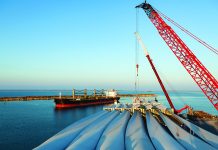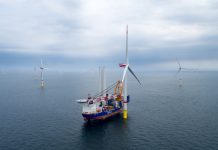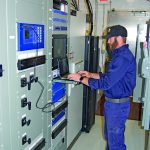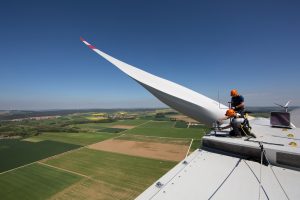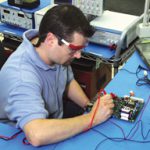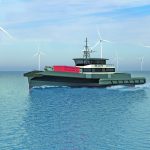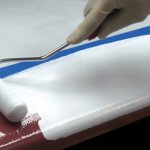ITH Bolting Technology began life in Germany in May 1979. And as the family-owned company grew, it increased its presence all over the world, including the U.S. That’s where ITH Engineering does everything around the bolted joint, including those used in wind turbines.

ITH Bolting Technology has been supplying to the wind industry since 1982.
“Obviously in wind turbines there are a lot of bolts,” said Matt Rasper, president of ITH Engineering. “You have foundation studs; you have tower section bolts, bolts up in the nacelle to hold the nacelle to the tower and also blade studs. ITH is basically a bolting technology company. Our primary business has always been bolting tools.”
Complete System Supplier
ITH Engineering was founded in May 1999. In addition to the bolting tools, ITH is also involved with specialty hardware.
“ITH is a complete system supplier,” Rasper said. “We can supply the tools, hardware, services, and engineering for the wind applications. We have hydraulic bolt tensioners, torque wrenches, and nut runners (torque multipliers). We manufacture our own pump systems for the tools and have data collection software for bolting traceability.”
One of the company’s main goals is to assist OEMs and contractors in achieving more accurate and repeatable bolted connections. It’s a tooling and hardware manufacturer heavily focused on engineering and bolted joint design, he said.
 “We also help some OEMs with the bolt design itself,” Rasper said. “If they come to us with an application that they’re struggling with, we can give them advice on the bolted joint design or on which bolting method — tensioning or torqueing — is best suited for their application. We consider not only installation but also maintenance issues for bolted joints”.
“We also help some OEMs with the bolt design itself,” Rasper said. “If they come to us with an application that they’re struggling with, we can give them advice on the bolted joint design or on which bolting method — tensioning or torqueing — is best suited for their application. We consider not only installation but also maintenance issues for bolted joints”.
The main tools needed for wind turbines are hydraulic bolt tensioners and torque wrenches that are used during the erection, according to Rasper.
Maintenance-Free Hardware
But one of the things ITH is striving for is the creation of maintenance-free hardware. Annual bolt maintenance can be an expensive cost for wind sites.
“Over time, bolted connections can lose some of their preload due to vibration and relaxation,” Rasper said. “Due to possible loss of preload, these connections might need to be checked from time-to-time and retightened.”

ITH has been working with universities in Germany, the German Institute for Steel Constructions (DIBt) and a couple of wind-turbine OEMs to come up with a method to create hardware that will eliminate future maintenance requirements, he said. The company is striving for an improved hardware design that helps retain the original preload with only minimal load loss. The goal is to reduce and eventually eliminate the need for the maintenance checks.
“It’s a little bit more of an engineered and machined hardware than the industry typically uses,” Rasper said.
The industry currently uses an HV hardware — a standard for steel constructions — that’s rough and mass-produced.
“Ours is a machined, better quality product. Once you tighten the joint — because of how it’s machined — it retains its preload better over time,” Rasper said.
He said the ITH hardware has been used from two major wind-turbine manufacturers, and during these projects, the hardware was certified by the international accreditation body DNV-GL and German Technical Inspection Association TÜV to be maintenance-free for five years (DNV-GL), respectively for 20 years (TÜV).
This zero maintenance will serve to positively affect OEMs and contractors and their bottom line significantly, according to Rasper.
“The main benefit is to the wind-farm owners because it tremendously cuts out the maintenance and labor hours,” he said.
OEMs and Contractors
ITH’s main focus is with OEMs and contractors.
“We know all the OEMs who manufacture the turbines throughout the U.S.,” Rasper said. “So we focus our efforts mainly on the OEMs and the contractors because these are the people who buy the tools.”

ITH will also contact wind sites where it has local offices and travel to wind sites in order to see if they may need any assistance, according to Rasper.
“In many cases, when a wind turbine is built, it’s maintained by the OEM for a certain period of time before it’s transferred over, as far as maintenance goes, to the owners,” he said. “This is the point when the owners would typically need tooling. That’s when we would like to contact them.”
OEMs usually take care of the short-term service of a wind farm. For example, maybe the service contract is for the first two or three years, Rasper said.
“The OEM will have their own tools there, and they’ll take care of the units,” he said. “So when that service contract comes to an end, and it’s time for the OEM to move on, then the owner of the wind farm has to procure his own tooling, so that’s where there is an opportunity for us to potentially sell tools to that owner for maintaining it.”
With that in mind, ITH strives to improve the industry.
“ITH is always working to improve the safety of operations, the quality of the bolted joints, the process, and time used to tighten them,” Rasper said.

















